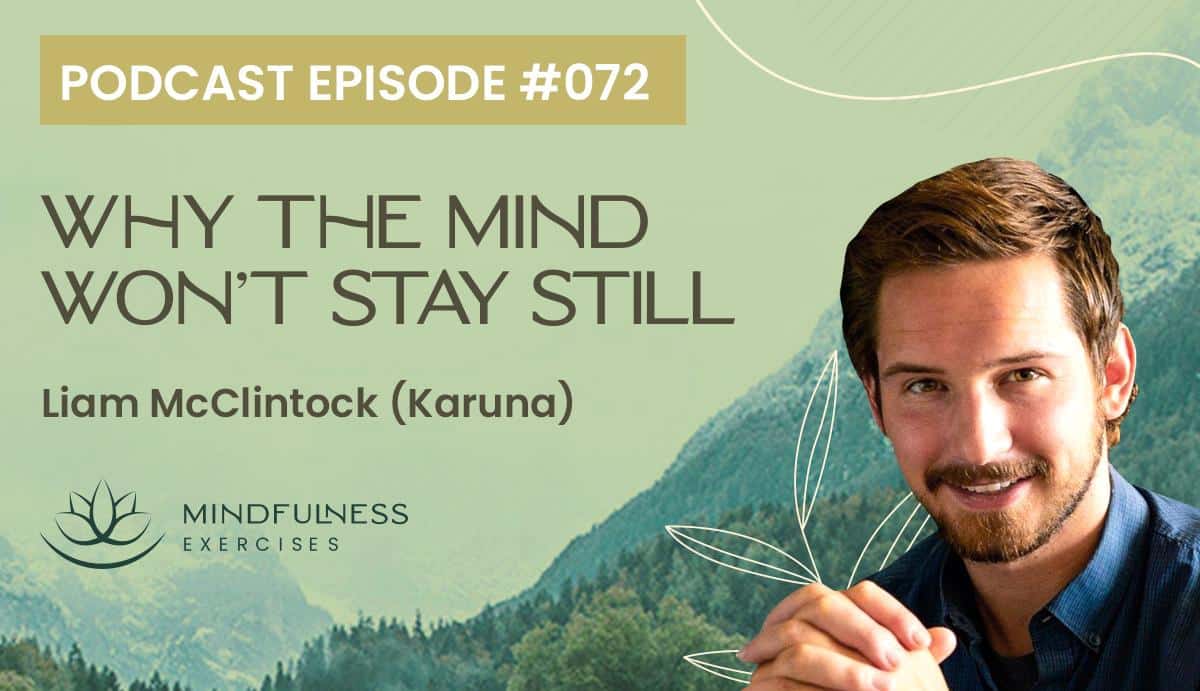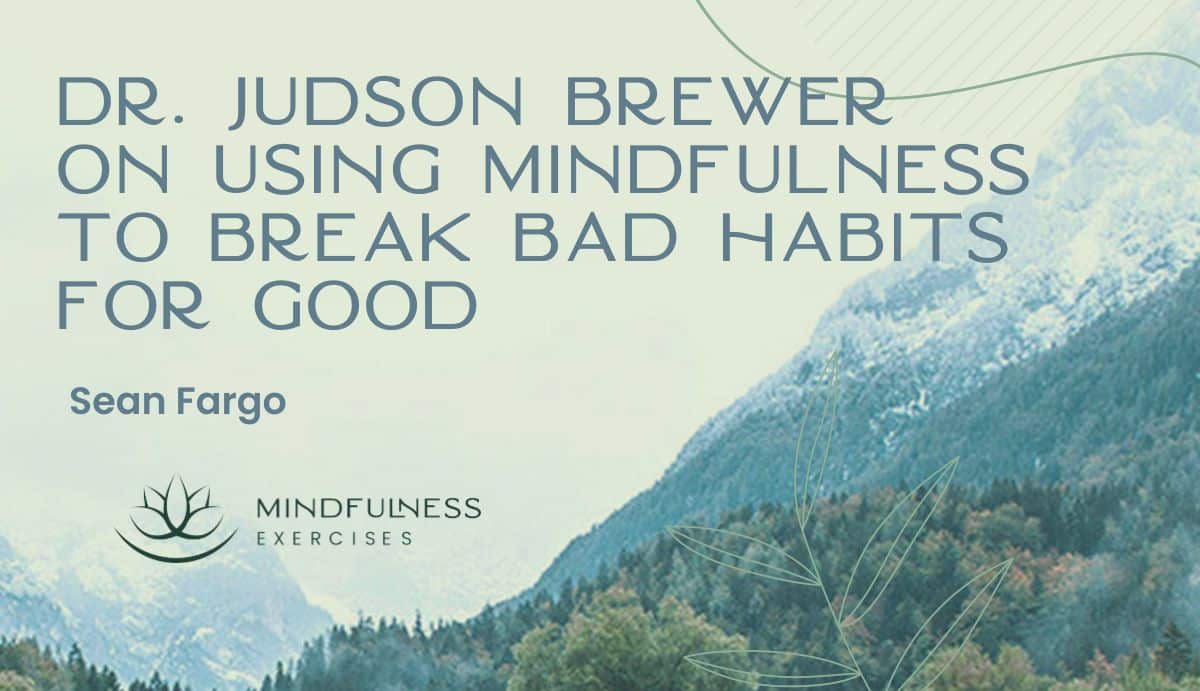Listen now

The directive to just ‘be here now’ as a solution to everyday discomfort and mental agitation sounds simple enough. But in practice, it’s not at all easy. Why does the mind seem to be inherently unstable?
In this episode, we hear from Liam McClintock, founder and CEO of FitMind and a graduate of the Mindfulness Exercises Mindfulness Meditation Teacher Training Program. He shares both ancient wisdom, and the latest neuroscience, to uncover the causes of our discontentment.
By understanding how the mind works, we can better work with it to realize lasting stability, happiness and calm.
This talk is a brief excerpt from Liam McClintock’s guest teacher presentation to those enrolled in our Mindfulness Meditation Teacher Training Program. Learn more about this unique, online, self-paced certification program at mindfulnessexercises.com/certify
What You’ll Learn in This Episode:
Show Notes:
The ubiquitous instability of the human mind
Meditation is simple, but it’s by no means easy. When we sit down to meditate, we notice how busy our minds really are. We seem to be in a near-constant state of agitation, stress or dis-ease. Our to-do list is constantly scrolling by, along with a variety of thoughts and emotions. In the Pāli language, this ubiquitous experience is called dukkha, which often gets translated as ‘suffering.’ But there’s more nuance to it than that.
“Traditionally this is known as dukkha, which is a Pāli word that comes from du, meaning bad, and kha, meaning whole. And it actually referred to the hole of a wheel with an axle. And so if the hole didn’t fit around the axle it would be a bumpy ride. And this is kind of what it’s like in the mind most of the time, right? It’s a bumpy ride. There’s some kind of agitation, something to do, some problem to fix.”
The craving that causes agitation in the mind
Once we recognize that we’re in a state of discontentment, we might next wonder what the cause is. For if there is a cause, that cause can be addressed and we can solve the problem of our wandering, agitated mind. The Buddha taught that the cause of our unsettledness is craving. This claim is also supported by neuroscience.
“Craving is the ‘I like it, I don’t like it’ mind. It’s wanting this moment to be different. It’s reactivity, it’s grasping. And traditionally, the word in Pāli is tanhā, which means thirst. And the cause of that dis-ease is this thirst for something to be a little bit different than it is.”
Three levels at which we experience craving
Karuna describes three ways in which we might experience craving, or reactivity to dis-ease. On the macro level, we might think we need something outside ourselves in order to be happy, such as a new home or new car. Then there’s everyday desire, which keeps us trapped in the habit of craving, such as reaching for a chocolate bar to ease our internal discomfort. The micro-level of craving is more subtle.
“If I slow down and I observe what comes before the craving, in that moment of needing the chocolate, it’s an uncomfortable feeling somewhere in my stomach or somewhere in my chest, it’s some kind of uncomfortable physical sensation that comes up after the thought of chocolate, and then causes this craving. [...] I need that feeling to go away, and that’s why I go for the chocolate.”
Reactivity to feeling tone as an underlying cause of craving
When we come in contact with our environment via the physical senses, we immediately assign a feeling tone to what we observe. That contact is filtered through the lens of our perception. It is either pleasant, unpleasant or neutral. Once we apply the label of ‘like’ or ‘dislike’, craving or aversion (the flip-side of craving) arises.
“Most of (the sensory data coming at us) is being ignored at any given moment. But whatever’s most salient, which is often a thought, [...] then the mind latches onto this thing. It finds it pleasant or dis-pleasant, so that’s the feeling tone, then after the feeling tone comes the craving, either wanting more of it or wanting to push it away. And then from the craving comes the agitation in the mind.”
Two methods of describing the cause of suffering
The Buddha described the chain of causality that leads to mental agitation using the 12 links of dependent origination. Neuroscientists describe this as predictive processing: In brief, our mind creates our world. We choose what to pay attention to based on previous experience, some inherited. Understanding the cause of our mental agitation can help us find the solution. You can learn more about this from Dr. Jud Brewer in Episode #054, Mindful Weight Loss Through Habit Change.
“Habits are basically what condition the beginning of the chain of causality. [...] Habits are continually feeding this loop. We’re then conditioning the next arising, the next moment. So you eat the chocolate bar, your brain goes, ‘that was good, I’m going to do that again next time that I get the same triggers.’”
Three programs that dictate our behavior
As a scientist, Karuna likes to make sense of the habitual cycle of discontentment by way of three distinct programs that run in our minds. Phylogenetic programming roots our behavior in evolution, in our genes and epigenetics. Ontogenetic programming is related to our conditioning. These first two programs are rooted in past history and are unaware of our present-moment environment. The third is mindfulness, or meta-cognition, which allows us to make new decisions based on what is actually going to lead to our happiness.
“Using (mindfulness) you notice this pattern playing out and you say, instead of reacting, because I know that’s not going to lead to anything good, it’s not going to make me feel satisfied, I’m just going to let this process go. I’m going to bring my attention back to my breath or back to my body and I’m just going to let that process go and I’m not going to feed into (phylogenetic or ontogenetic programming) because that is no longer useful. That is not leading to my wellbeing.”
Creating neuroplastic change with mindfulness
Each time we mindfully choose to step out of habit, we create change in the brain. At first, making this choice takes effort. It’s not easy to leave behind multiple generations of genetic programming and conditioning. But with practice, we can bring mindfulness to the forefront as the program that drives our behavior.
“This is mind training. [...] There’s the formal practice where we sit down and cultivate this ability for self-directed neuroplasticity, for mindfulness. And then there’s the everyday process of bringing this into your daily life. Noticing how the mind’s attention is moving, noticing what’s triggering and agitating it, and letting go of those things.”
Additional Resources:

About Liam McClintock (Karuna)
Liam McClintock is the Founder & CEO of FitMind, a science-based mind training app. Liam has given mental health talks at Fortune 500 companies, addiction centers, schools, and government organizations. He hosts The FitMind Podcast, engaging various experts on the mind ranging from neuroscientists and monks to big wave surfers and memory champions.
Liam has an M.S. in Applied Neuroscience from King’s College London and consults on mindfulness and meditation research. He has spent time as a monastic at Dhammasukha Monastery and is a graduate of the Mindfulness Exercises Teacher Training Certification Program.
McClintock’s work has been featured in Forbes, Time, Vice, Daily Mail, Cosmopolitan, NBC, and Men’s Health. He is currently working on his first book Fitmind: The New Science & Ancient Practice Of Mental Fitness, forthcoming in 2024 with Avery Publishing.






